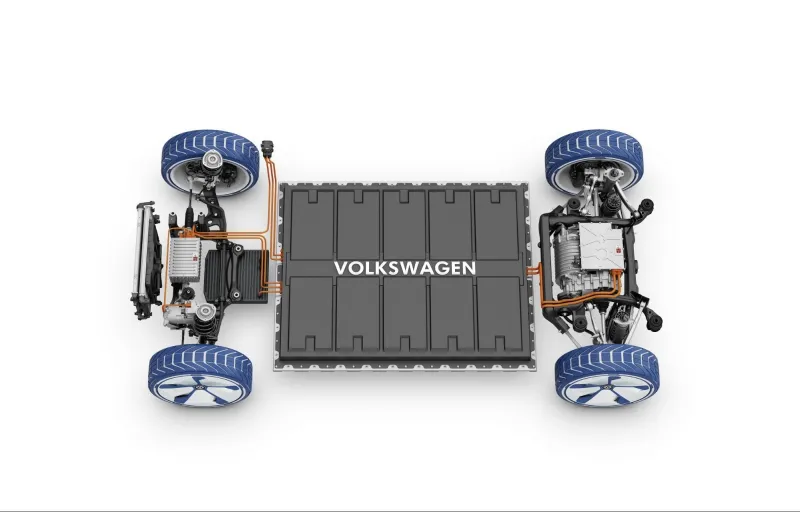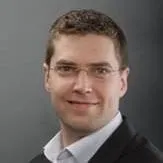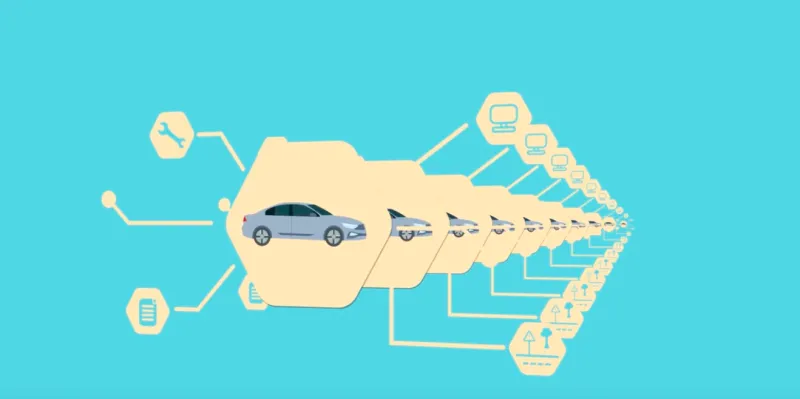When Volkswagen AG arrived at the Red Hat Open Innovation Lab two years ago, the company was looking for a solution to help them build self-driving autonomous cars. The venerable German automaker had all the internal pieces required to build those cars and write that software, but sometimes the trouble with self-driving cars is that last step through which all software must pass: testing.

Michael Denecke, head of Test Technology at Volkswagen AG, had a testing problem to solve, and a short time to solve it. On top of that, he also had a culture problem; the company had been charged with shifting to a less top-down cultural model.
“My job at Volkswagen is to make sure all the electronic control units we have in our cars work together,” said Denecke, speaking in the Red Hat Summit 2019 keynote. “Due to the new challenge of having autonomous driving connected cars and the many new functions for driver systems, we noticed that the normal way we do the tests with our dedicated hardware would not be enough. So we got the idea to have all these things--[what if we moved] all these tests we do with hardware on to virtual test environments? That’s why we came to containers in OpenShift: to put on these virtual test environments in containers in OpenShift environments.”
 Denecke is a veteran IT professional, so he didn’t just pick OpenShift out of a hat. “I led the group IT cloud project, therefore I knew a lot of IT vendors. I talked to them, and to be honest, Red Hat was the only one who said ‘OK, cool idea, let’s start!’”
Denecke is a veteran IT professional, so he didn’t just pick OpenShift out of a hat. “I led the group IT cloud project, therefore I knew a lot of IT vendors. I talked to them, and to be honest, Red Hat was the only one who said ‘OK, cool idea, let’s start!’”Marcus Greul is an IT project manager at Volkswagen AG. He works in testing and simulation research and development in Wolfsburg, Lower Saxony, Germany. He’s on Denecke’s team.
“Integration testing is one of the most complex tasks in automotive development,” said Greul, speaking at a recent OpenShift Commons Gathering. “Why? Electronic systems in the car consist of several components: sensors, activators, and control units. Those control units contain one or more software components, and those components need to integrate with each other... Integration testing means that such electronic systems in the car need to pass the integration testing process for each combination of components. For each model, and line, and every software version in the car... The more capabilities those systems gain in terms of taking over control of the car, the more test cases are needed to prove these can pass the testing process.”
And what if the output of those tests is meaningless to a human without further processing? What if those tests aren’t just pushing long strings into a text input box, but rather, stomping on the virtual gas pedal on a virtual freeway? Just setting up such a scenario requires an entire stack of virtuality upon which to test and derive results, said Greul.
“First, we need the time to build a virtual environment,” said Greul. “We would not test in the real world, so additionally, we need the virtual car... To simulate the customers’ interaction with the system, a virtual driver is put in the virtual car... The system under test, or the test object could be a software component, the control unit itself, or the complete system, or a couple of systems which represent the function.”

Such a testing system requires output that can be visually assessed by a human: a video. And because these tests are in a virtual 3D environment with virtual physics, GPUs could make the entire process into one that, conceivably, could run in a shorter amount of time in a large cluster. Those output videos would show just what happened when the test failed: did the car go off the road? Did it hit another car? Did it not move at all?
“What does all of this have to do with OpenShift? Let’s assume there’s a test bench where all the necessary components are just software running on some hardware. Components, such as virtual environments, data analytics, other tools, test cases, test case execution, or simulations of traffic, and the software components which go to a control unit. When all those are instantiated, the test bench might be setup and ready in just a few minutes, compared to let’s say, a few weeks. But in terms of exponential growth, this won’t be good enough. What we really need is massive scalability and automation. Fully automated test benches..., executing hundreds of thousands of test cases without manual effort: this is where we need to go,” said Greul.
 “We started on this two years ago: how can such scalability and automation be added to our test centers? Those test benches can be described as an OpenShift template, and those templates can be instantiated by an intelligent automation system. It’s possible to fire up hundreds of those test benches automatically with this system,” said Greul.
“We started on this two years ago: how can such scalability and automation be added to our test centers? Those test benches can be described as an OpenShift template, and those templates can be instantiated by an intelligent automation system. It’s possible to fire up hundreds of those test benches automatically with this system,” said Greul.But it wasn’t just the way that Volkswagen tested its software that changed: their culture is beginning to change as well. That was a big part of the appeal of working with Red Hat Open Innovation Labs, coupled with the tight timeframe in which the company was looking to find a solution.
 Said Denecke, “We didn’t have much time to prove our idea to top management... When I talked to my colleagues from Red Hat they said, ‘We’ve got a product called the Open Innovation Lab, and it’s the only chance to meet that goal in that time frame.’ The other thing that made the Innovation Lab appealing to me is that changing culture is a big thing at Volkswagen. Working together in the Open Innovation Lab way says; ‘don’t be so top-down management driven, give the responsibility to the team,’ and we want to do that at Volkswagen.”
Said Denecke, “We didn’t have much time to prove our idea to top management... When I talked to my colleagues from Red Hat they said, ‘We’ve got a product called the Open Innovation Lab, and it’s the only chance to meet that goal in that time frame.’ The other thing that made the Innovation Lab appealing to me is that changing culture is a big thing at Volkswagen. Working together in the Open Innovation Lab way says; ‘don’t be so top-down management driven, give the responsibility to the team,’ and we want to do that at Volkswagen.”
Denecke said that the open development model was the key to the successful development of their new testing model. “We proved we can have virtual test environments. First, we proved that we can mix virtual test environments with real test environments--I think that was the new thing in this idea--and we showed that for quality and success, the main factor is changing the culture and working together... The question from the manager should not be, ‘What’s the status?’ But, ‘How can I as a manager help you?’”

Two years ago, when Volkswagen’s team arrived at Red Hat Open Innovation Labs, it was known that their existing testing systems would not stand up to the coming influx of demand. At the time, there was no off-the-shelf way to support GPUs in containers with Kubernetes and OpenShift. Together, Red Hat and Volkswagen built that system.
저자 소개
Red Hatter since 2018, technology historian and founder of The Museum of Art and Digital Entertainment. Two decades of journalism mixed with technology expertise, storytelling and oodles of computing experience from inception to ewaste recycling. I have taught or had my work used in classes at USF, SFSU, AAU, UC Law Hastings and Harvard Law.
I have worked with the EFF, Stanford, MIT, and Archive.org to brief the US Copyright Office and change US copyright law. We won multiple exemptions to the DMCA, accepted and implemented by the Librarian of Congress. My writings have appeared in Wired, Bloomberg, Make Magazine, SD Times, The Austin American Statesman, The Atlanta Journal Constitution and many other outlets.
I have been written about by the Wall Street Journal, The Washington Post, Wired and The Atlantic. I have been called "The Gertrude Stein of Video Games," an honor I accept, as I live less than a mile from her childhood home in Oakland, CA. I was project lead on the first successful institutional preservation and rebooting of the first massively multiplayer game, Habitat, for the C64, from 1986: https://neohabitat.org . I've consulted and collaborated with the NY MOMA, the Oakland Museum of California, Cisco, Semtech, Twilio, Game Developers Conference, NGNX, the Anti-Defamation League, the Library of Congress and the Oakland Public Library System on projects, contracts, and exhibitions.
유사한 검색 결과
Key considerations for 2026 planning: Insights from IDC
Red Hat and Sylva unify the future for telco cloud
Air-gapped Networks | Compiler
Can Kubernetes Help People Find Love? | Compiler
채널별 검색
오토메이션
기술, 팀, 인프라를 위한 IT 자동화 최신 동향
인공지능
고객이 어디서나 AI 워크로드를 실행할 수 있도록 지원하는 플랫폼 업데이트
오픈 하이브리드 클라우드
하이브리드 클라우드로 더욱 유연한 미래를 구축하는 방법을 알아보세요
보안
환경과 기술 전반에 걸쳐 리스크를 감소하는 방법에 대한 최신 정보
엣지 컴퓨팅
엣지에서의 운영을 단순화하는 플랫폼 업데이트
인프라
세계적으로 인정받은 기업용 Linux 플랫폼에 대한 최신 정보
애플리케이션
복잡한 애플리케이션에 대한 솔루션 더 보기
가상화
온프레미스와 클라우드 환경에서 워크로드를 유연하게 운영하기 위한 엔터프라이즈 가상화의 미래
